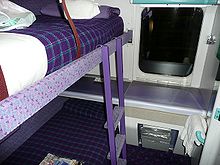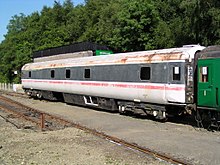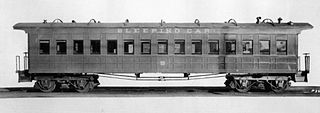
The sleeping car or sleeper is a railway passenger car that can accommodate all passengers in beds of one kind or another, for the purpose of sleeping. George Pullman was the American innovator of the sleeper car.

Great Western Railway (GWR) is a British train operating company owned by FirstGroup that operates the Greater Western passenger railway franchise. It manages 197 stations and its trains call at over 270. GWR operates long-distance inter-city services along the Great Western Main Line to and from the West of England and South Wales, inter-city services from London to the West Country via the Reading–Taunton line, and the Night Riviera sleeper service between London and Penzance. It provides outer-suburban services in West London; commuter services from its London terminus at Paddington to the Thames Valley region, including parts of Berkshire and Buckinghamshire, and Oxfordshire; and regional services throughout the West of England and South Wales to the South coast of England. Great Western Railway provides and maintains the Electrostar Class 387 fleet for Heathrow Express.

InterCity was introduced by British Rail in 1966 as a brand-name for its long-haul express passenger services.
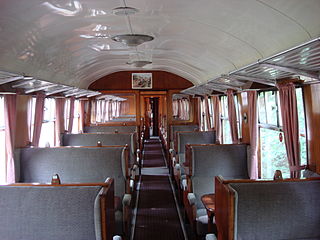
British Rail Mark 1 is the family designation for the first standardised designs of railway carriages built by British Railways (BR) from 1951 until 1974, now used only for charter services on the main lines or on preserved railways.

The British Rail Mark 3 is a type of passenger carriage developed in response to growing competition from airlines and the car in the 1970s. A variant of the Mark 3 became the rolling stock for the High Speed Train (HST).

Newton Abbot railway station serves the market town of Newton Abbot in Devon, England. It is 214 miles 5 chains (345 km) from London Paddington. The station today is managed by Great Western Railway, who provide train services along with CrossCountry.

St Austell station is a Grade II listed station which serves the town of St Austell, Cornwall, England. It is 286 miles 26 chains from the zero point at London Paddington measured via Box and Plymouth Millbay. The station is operated by Great Western Railway.

Caledonian Sleeper is the collective name for overnight sleeper train services between London and Scotland, in the United Kingdom. It is one of only two currently operating sleeper services on the railway in the United Kingdom, the other being the Night Riviera which runs between London and Penzance.
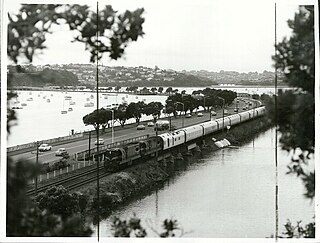
The Silver Star was a luxury passenger train that ran overnight between Auckland and Wellington on the North Island Main Trunk (NIMT) railway of New Zealand, operated by New Zealand Railways (NZR). The train ran from Monday 6 September 1971 until Sunday 8 June 1979. It replaced the Night Limited express passenger trains which provided a faster service than the ordinary express trains, by stopping at only six intermediate stations en route and not hauling a postal (sorting) van as on previous trains.

The Night Riviera is a sleeper train operated by Great Western Railway (GWR). It is one of only two sleeper services on the railway in the United Kingdom. The Night Riviera runs six nights a week (Sunday–Friday) between London Paddington and Penzance with one train in each direction.

Old Oak Common TMD was a traction maintenance depot located west of London Paddington, in Old Oak Common. The depot codes were OC for the diesel depot and OO for the carriage shed. In steam days the shed code was 81A.

Penzance TMD, also known as Long Rock TMD, is a railway traction maintenance depot situated in the village of Long Rock east of Penzance, Cornwall, England, and is the most westerly and southerly rail depot in the country. The depot operator is Great Western Railway. The depot code is PZ.
The Nightstar was a proposed overnight sleeper train service from various parts of the United Kingdom to destinations in mainland Europe, via the Channel Tunnel, in the mid 1990s. To run alongside the Eurostar, and north of London day-time Regional Eurostar services which were never operational, the Nightstar was the last part in a proposed round-the-clock passenger train utilisation of the Channel Tunnel.
The Sydney–Melbourne Express was an overnight intercapital passenger train service that operated between Australia's largest two cities, Sydney and Melbourne, between August 1986 and November 1993. Operated jointly by State Rail Authority and V/Line the name depended on the direction of travel, with the train nicknamed the 'Sex' or 'Mex'.

The NZR 56-foot carriage is a class of 56 ft (17 m) long railway passenger carriage formerly used on almost all long-distance passenger rail transport in New Zealand. 88 carriages have been preserved.

The passenger coaches of the Great Western Railway (GWR) were many and varied, ranging from four and six-wheeled vehicles for the original broad gauge line of 1838, through to bogie coaches up to 70 feet (21 m) long which were in service through to 1947. Vacuum brakes, bogies and through-corridors all came into use during the nineteenth century, and in 1900 the first electrically lit coaches were put into service. The 1920s saw some vehicles fitted with automatic couplings and steel bodies.

The Mid-Norfolk Railway has a large collection of heritage rolling stock, mostly relating to the post-war British Railways-era, from the 1950s to 1990s. The line holds several rolling-stock accomplishments:
This article is intended as a catalogue of sleeping carriages used by the Victorian Railways and successors.

The British Rail Mark 5 is the designation given to locomotive-hauled rail carriages built by Spanish manufacturer CAF for operation with Caledonian Sleeper.
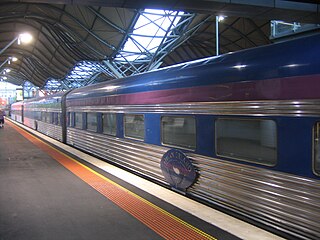
The first carriages built specifically for The Overland train service operated by the Victorian and South Australian Railways (V & SAR) were introduced in 1949. By the end of 1951, eight new sleeping cars and six new sitting cars had entered service. Additions to the fleet continued until 1972; in all, 44 carriages were built. About eight were still in service in March 2020 on The Overland operated by Journey Beyond. Other carriages have been transferred to different services or sold.

